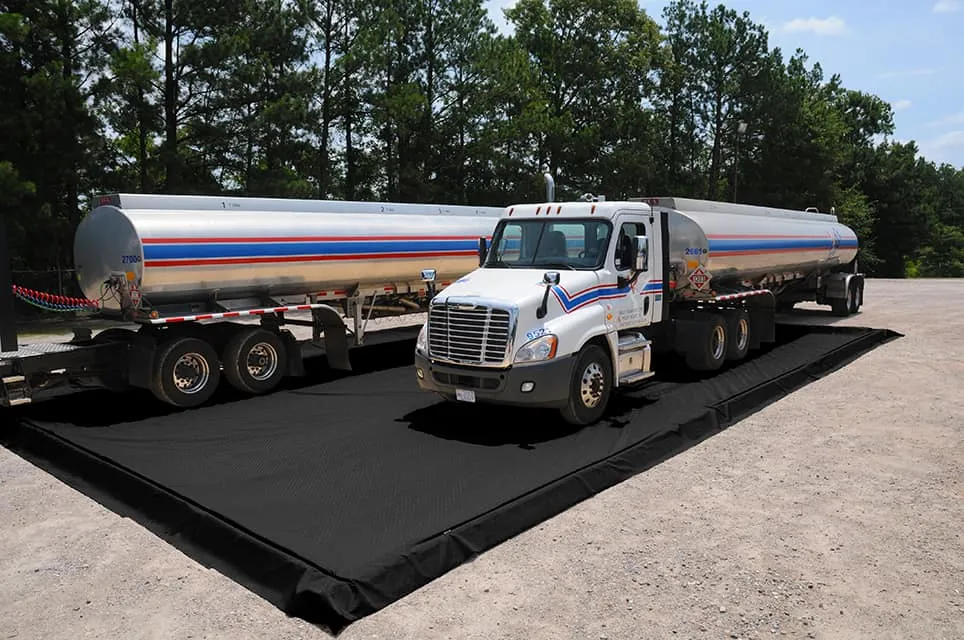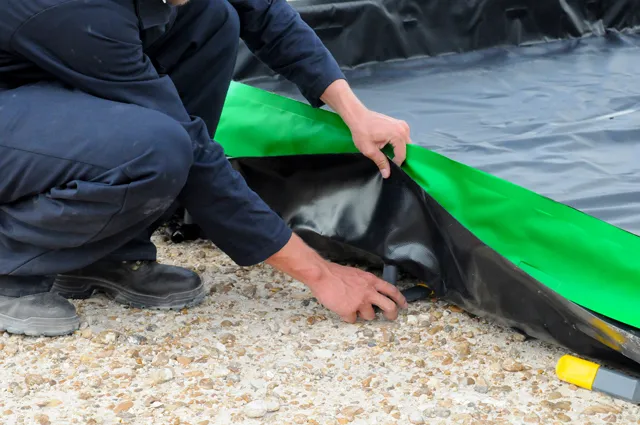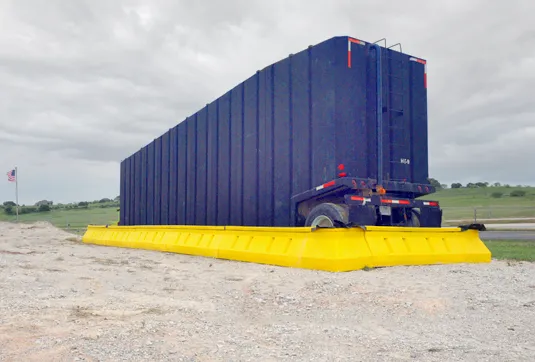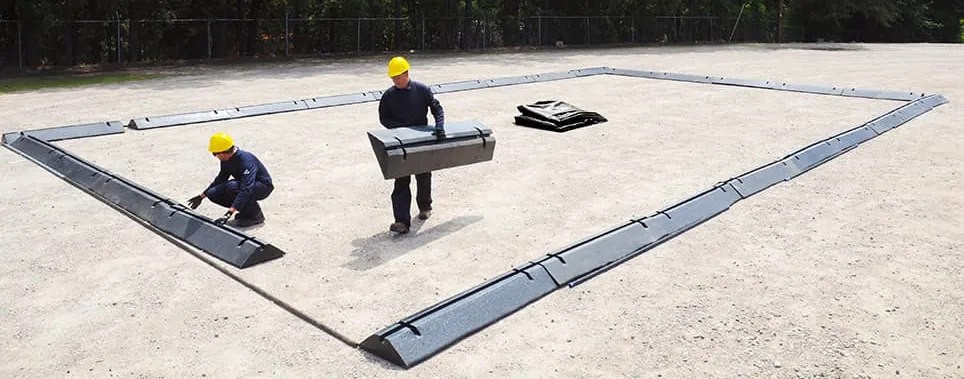
At SafeRack, we understand that professionals in industries like Oil & Gas, chemical processing, and transportation need reliable solutions for tanker truck spill containment. Compliance with SPCC (Spill Prevention, Control, and Countermeasure) regulations and EPA containment requirements is essential, but so is selecting containment solutions that are built to last in rugged environments.
Too often, companies opt for quick-fix solutions that are inexpensive upfront but fail under the weight of heavy equipment or rough terrain. That’s why planning ahead with durable, high-quality containment solutions is key to preventing spills, protecting the environment, and avoiding costly penalties.
What is Tanker Truck Spill Containment?
Tanker truck spill containment includes secondary containment systems designed to capture spills or leaks that may occur outside the vehicle. This helps prevent:
- Groundwater and soil contamination
- Safety hazards such as slips, trips, and falls
- Regulatory violations that could result in fines or shutdowns
- Costly cleanup efforts that impact operational efficiency
By implementing proper containment, companies can maintain compliance with federal and state regulations while ensuring a safer work environment.
Why Spill Containment is Critical
Leaks from tanker trucks and frac tanks can occur during transportation or stationary operations, making containment solutions essential. Without proper systems in place, companies face:
- Fines for environmental violations
- Increased cleanup costs
- Potential legal liability if workers or the public are exposed to hazardous substances
- Reputational damage that could affect future business opportunities
Investing in reliable spill containment solutions ensures compliance, prevents accidents, and safeguards both employees and the environment.
Spill Containment Solutions for Tanker Trucks
Spill containment isn’t a one-size-fits-all approach. Different operations require different solutions.
At SafeRack, we offer various spill containment systems to match your specific needs:

Foam Wall Drive Over Spill Containment Berms
Low profile drive over foam wall is perfect for equipment maintenance and portable drum containment
- Soft Foam Sidewalls – Compress for easy drive-over access.
- Quick Deployment – No setup required; unfolds easily and stores compactly.

Rapid Rise
Sidewalls stay lowered and out of the way until they are needed
- Hassle-Free Access – Sidewalls stay down for easy drive-in/out operation.
- Automatic Containment – Foam ring rises with spilled liquid to contain spills.

Wall Ultimate Spill Containment Berm
Unique, “Living Hinge” design by Ultratech products allows hands-free drive in/drive out – No need to manually raise or lower the endwalls
- Self-Resetting Sidewalls – Collapse in either direction and spring back automatically.
- Easy Access – Drive trucks or roll drums over; sidewalls return upright without assistance.

Collapsible Wall Spill Containment Berm
Economical design sets up quickly and provides secure containment
- Rugged PVC Support – Durable sidewall assemblies for reliable containment.
- Quick Adjustment – Swivel feet allow fast raising or lowering of sidewalls.

High-Capacity Spill Containment Walls
Modular, hard-walled system provides long-term, high-capacity spill containment.
- High-Capacity Containment – Holds more liquid than shorter-walled systems.
- Semi-Permanent Solution – Ideal for large, long-term spill containment.

Modular Spill Containment Berms
Modular spill containment berms can be customized and reused for many different types of applications.
- Adjustable Containment – Modular foam blocks fit any space.
- Heavy-Duty Design – 6’ foam sidewalls withstand heavy equipment drive-overs.
EPA & SPCC Compliance for Truck Spill Containment
Understanding Regulatory Requirements
To ensure environmental protection and workplace safety, tanker truck spill containment must comply with the following EPA and SPCC (Spill Prevention, Control, and Countermeasure) regulations:
1. SPCC Rule (40 CFR Part 112)
- Applies to facilities storing 1,320+ gallons of oil in aboveground containers or 42,000+ gallons in underground storage.
- Requires secondary containment for tanker trucks and storage areas to prevent oil discharges into navigable waters.
- Facilities must have an SPCC Plan outlining spill prevention measures, training programs, and emergency response procedures.
2. EPA Secondary Containment Requirements
- Must prevent discharges to nearby water sources or storm drains.
- Containment structures must hold 110% of the largest container’s capacity to account for rainfall or leaks.
- Solutions include spill berms, containment pallets, and trench systems.
3. Stormwater Pollution Prevention Plan (SWPPP)
- Mandates Best Management Practices (BMPs) to minimize pollutant runoff from spills or leaks.
- Requires regular inspections, training, and proper spill response plans.
4. Spill Response & Cleanup Standards
- Facilities must have spill kits and containment measures in place.
- Spills must be reported and cleaned up immediately to prevent environmental hazards.
Benefits of Planning Ahead
Taking proactive steps to implement the right spill containment solutions prevents costly emergencies and reduces operational risks. Some key benefits include:
- Regulatory Compliance – Avoid EPA violations and SPCC fines
- Cost Savings – Prevent expensive spill cleanups and reduce downtime
- Workplace Safety – Protect employees and reduce the risk of chemical exposure
- Operational Efficiency – Minimize disruptions and maintain productivity
Most spill berms and containment systems are reusable and easy to store, making them a cost-effective investment for long-term use.
Find the Right Spill Containment Solution for Your Needs
Now that you understand the importance of proper spill containment, SafeRack can help you choose the best solution for your tanker trucks, frac tanks, and industrial spill containment needs.
Contact our spill containment experts today for a no-obligation quote and ensure your site is compliant, safe, and prepared for any spill scenario.





